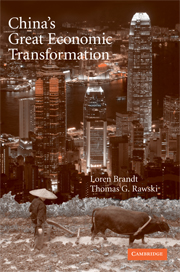Book contents
- Frontmatter
- Contents
- List of Figures
- List of Tables
- Contributors
- Acknowledgments
- Map
- 1 China's Great Economic Transformation
- 2 China and Development Economics
- 3 China in Light of the Performance of the Transition Economies
- 4 A Political Economy of China's Economic Transition
- 5 The Demographic Factor in China's Transition
- 6 The Chinese Labor Market in the Reform Era
- 7 Education in the Reform Era
- 8 Environmental Resources and Economic Growth
- 9 Science and Technology in China
- 10 The Political Economy of Private Sector Development in China
- 11 The Role of Law in China's Economic Development
- 12 China's Fiscal System: A Work in Progress
- 13 Agriculture in China's Development: Past Disappointments, Recent Successes, and Future Challenges
- 14 China's Financial System: Past, Present, and Future
- 15 China's Industrial Development
- 16 China's Embrace of Globalization
- 17 Growth and Structural Transformation in China
- 18 Income Inequality during China's Economic Transition
- 19 Spatial Dimensions of Chinese Economic Development
- 20 Forecasting China's Economic Growth to 2025
- Index
19 - Spatial Dimensions of Chinese Economic Development
Published online by Cambridge University Press: 24 May 2010
- Frontmatter
- Contents
- List of Figures
- List of Tables
- Contributors
- Acknowledgments
- Map
- 1 China's Great Economic Transformation
- 2 China and Development Economics
- 3 China in Light of the Performance of the Transition Economies
- 4 A Political Economy of China's Economic Transition
- 5 The Demographic Factor in China's Transition
- 6 The Chinese Labor Market in the Reform Era
- 7 Education in the Reform Era
- 8 Environmental Resources and Economic Growth
- 9 Science and Technology in China
- 10 The Political Economy of Private Sector Development in China
- 11 The Role of Law in China's Economic Development
- 12 China's Fiscal System: A Work in Progress
- 13 Agriculture in China's Development: Past Disappointments, Recent Successes, and Future Challenges
- 14 China's Financial System: Past, Present, and Future
- 15 China's Industrial Development
- 16 China's Embrace of Globalization
- 17 Growth and Structural Transformation in China
- 18 Income Inequality during China's Economic Transition
- 19 Spatial Dimensions of Chinese Economic Development
- 20 Forecasting China's Economic Growth to 2025
- Index
Summary
INTRODUCTION
The spatial arrangement of population and economic activities is an important and complex dimension of Chinese economic development. Yet it is understudied, with Yuan-li Wu's (1967) classic work, The Spatial Economy of Communist China, standing as the last comprehensive analysis, which is now seriously outdated. This present chapter is not intended to be its update. Instead, we aim at a more modest goal: to examine two key aspects of changes the Chinese spatial economy has undergone in the past half century, with a focus on the last ten or fifteen years. These two changes are (a) the extensive urbanization that has occurred since the early 1980s, involving migration from rural areas to traditional cities and industrialization of the rural sector with growth of many townships into urban centers and expansion of existing cities and (b) the changing spatial inequalities across provinces, resulting from allocation of state investment and budgetary resources, distribution of foreign direct investment (FDI), and other pertinent factors. It is hoped that this chapter will help the reader to understand the enormous changes in the spatial configurations of the Chinese economy, how they are shaped by the institutional landscape and policies, and how they have impinged on economic development.
As a prelude to our subsequent discussion, it is useful at the outset to briefly highlight some critical economic thinking on the importance of the spatial dimension in the process of development.
- Type
- Chapter
- Information
- China's Great Economic Transformation , pp. 776 - 828Publisher: Cambridge University PressPrint publication year: 2008
- 24
- Cited by



